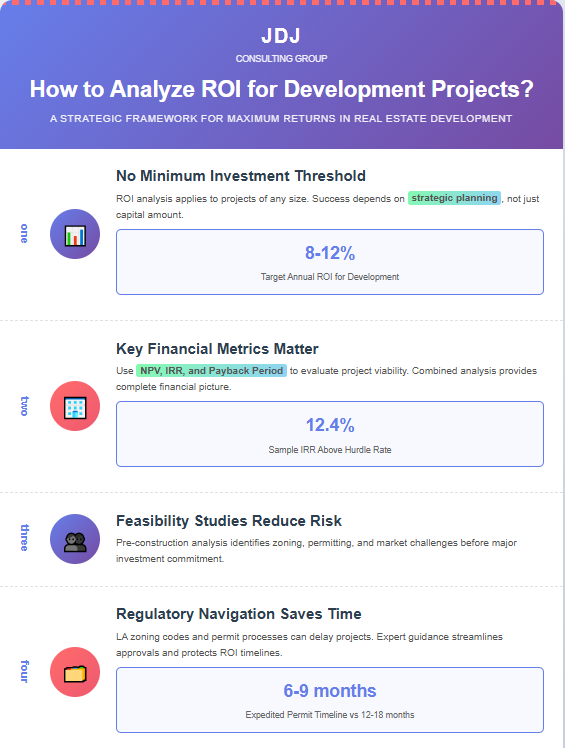How to Analyze ROI for Construction Projects | JDJ Consulting Group
When planning a new development, numbers tell the story. But those numbers must be put into context—costs, revenues, timelines, risks, and approvals all influence whether a project succeeds. For property developers in Los Angeles and beyond, analyzing return on investment (ROI) is not just a calculation. It is a decision-making tool that shapes everything from land purchase to final sale.
Table of Contents
ToggleAt JDJ Consulting Group, we help clients use ROI analysis to see projects clearly before breaking ground. Whether it’s a mixed-use tower, a subdivision, or a retail development, a structured ROI review answers one key question: Will this project deliver sustainable returns worth the investment?

Why ROI Analysis Matters in Real Estate Development
Real estate is capital-intensive. Developers commit millions before the first tenant moves in. This is why measuring ROI early can prevent wasted time, stalled projects, and unexpected financial loss.
ROI analysis matters for three main reasons:
Investor confidence – Lenders and equity partners want proof the project will pay off.
Project feasibility – ROI reveals if revenues can realistically cover costs and risks.
Strategic planning – Developers can test different design or phasing options to improve results.
At JDJ Consulting Group, we have seen how ROI calculations guide smarter choices. A project with strong returns not only attracts financing but also builds trust with city officials and stakeholders.
Table 1: Benefits of ROI Analysis in Development Projects
| Benefit | Why It Matters |
|---|---|
| Financial clarity | Ensures project costs and revenues are balanced before major commitments. |
| Reduced risk | Highlights potential delays, overruns, or zoning issues early. |
| Stronger funding opportunities | Provides evidence to banks and investors for securing capital. |
| Smarter project decisions | Allows testing of design, density, or phasing to maximize profit. |
| Stakeholder alignment | Builds confidence with partners, agencies, and future buyers. |
Key Metrics and Methodologies for ROI Analysis
Not all ROI is measured the same way. Different metrics offer different insights into a project’s performance. Developers often combine several tools to get the full picture.
Here are the most important methods used in real estate development ROI analysis:
Net Present Value (NPV)
What it is: NPV calculates the present value of expected future cash flows minus total costs.
Why it matters: It helps investors compare today’s dollar value of a project with the money being invested. If NPV is positive, the project adds value.
Internal Rate of Return (IRR)
What it is: The IRR is the discount rate that makes the NPV equal zero.
Why it matters: It shows the rate of return a project is expected to generate. Many investors use IRR as a benchmark to compare projects.
Payback Period
What it is: The time it takes to recover the initial investment.
Why it matters: It’s a simple measure of liquidity—useful for developers who want faster returns, even though it ignores future cash flow.
Table 2: Common ROI Metrics for Development Projects
| Metric | Key Use Case | Strengths | Limitations |
|---|---|---|---|
| NPV | Comparing costs and revenues over time | Accounts for time value of money | Requires reliable cash flow projections |
| IRR | Benchmarking project return rates | Easy to compare against hurdle rates | Can give misleading results with uneven flows |
| Payback Period | Measuring time to recover investment | Simple and intuitive | Ignores returns after payback period |
| ARR (Accounting RR) | Quick comparison of accounting profits | Uses familiar accounting figures | Doesn’t factor in time value of money |
| BCR (Benefit-Cost) | Showing efficiency of costs vs. benefits | Simple ratio, easy to explain | Less detailed than NPV or IRR |
Framework for Conducting ROI Analysis on Development Projects
Knowing the numbers is one thing. Knowing how to apply them is another. At JDJ Consulting Group, we guide clients through a clear framework that connects financial models with real-world project details. Here’s how developers can structure their ROI review from concept to execution.

1st Step – Define Objectives, Scope, and Success Criteria
Every ROI study begins with clarity. Before running calculations, a developer should ask:
What type of project is being proposed—residential, mixed-use, commercial?
What return threshold will make this project worthwhile?
What are the non-financial goals—such as community value, long-term ownership, or sustainability?
For example, an investor may want a minimum acceptable rate of return (MARR) of 12%. Another might focus on steady rental income, even if the initial IRR is modest. JDJ helps refine these targets so the ROI analysis reflects the developer’s true priorities.
2nd Step – Conduct a Pre-Construction Feasibility Study
ROI is only as accurate as the assumptions behind it. A feasibility study provides the foundation for every financial model.
At JDJ Consulting Group, our feasibility process typically includes:
Reviewing site conditions and zoning restrictions.
Assessing entitlement and permit requirements.
Estimating construction and soft costs.
Forecasting revenues from rents or sales.
Identifying risks such as delays, financing hurdles, or design challenges.
By running this study early, developers avoid surprises that can sink ROI later. It also gives lenders and stakeholders confidence that the project has been stress-tested before moving forward.
Quick ROI Calculator
3rd Step – Gather Detailed Cost and Revenue Data
Once the feasibility groundwork is in place, the next step is breaking down costs and revenues in detail. Numbers here must be specific and realistic.
Typical cost categories include:
Land acquisition – purchase price, legal fees, title costs.
Hard costs – materials, labor, site prep, utilities.
Soft costs – architects, engineers, consultants, permitting.
Financing costs – interest, loan fees, reserves.
Contingency – usually 5–10% of hard and soft costs.
Revenue projections may include:
Sale prices of units or commercial spaces.
Rental income and absorption rates.
Ancillary revenue (parking, amenities, retail leases).
4th Step – Analyze Regulatory and Market Constraints
Even the best pro forma can collapse under local restrictions. In Los Angeles and other major cities, zoning, entitlements, and permit reviews directly affect ROI.
Key factors to review include:
Zoning rules – density, height limits, parking requirements.
Entitlement process – how long it may take to secure approvals.
Permit fees and timelines – delays can drain financing and push back revenue.
Market demand – are sales prices or rental rates rising, flat, or declining?
At JDJ Consulting Group, our team helps clients navigate these hurdles. We act as a liaison with city agencies, ensuring compliance while minimizing costly delays. When ROI depends on hitting a schedule, time saved in permitting can equal real profit.
Payback Period Estimator
5th Step – Calculate ROI Metrics
With assumptions and data in place, developers can now run the financial tests. Each metric reveals a different side of the project’s performance.
Example simplified calculation:
Total Project Cost: $20 million
Projected Cash Flow (10 years): $30 million
Discount Rate: 8%
NPV: +$3.5 million → Project adds value
IRR: 12.4% → Above hurdle rate
Payback Period: 6 years → Acceptable for investors
By combining these metrics, developers see both the short-term payback potential and the long-term profitability. At JDJ, we often model several scenarios—best case, base case, and worst case—so clients can compare outcomes.
6th Step – Perform Risk Analysis and Sensitivity Testing
ROI is never static. Market changes, interest rates, or unexpected construction costs can shift results overnight. That’s why risk analysis is essential.
Common risk areas include:
Cost overruns from labor shortages or materials.
Financing shifts if interest rates climb.
Market absorption delays if units sell or lease slower than expected.
Regulatory delays if permits take longer than forecasted.
A sensitivity analysis tests how ROI changes when one factor moves. For example, what happens if rents fall by 5%? What if costs increase by 10%?
This type of testing helps developers see whether the project can withstand real-world stress. At JDJ, we also apply Benefits Realization Management (BRM) principles—tracking whether promised financial and strategic benefits actually materialize over time.
NPV & IRR Calculator
7th Step – Make Informed Decisions and Refine Strategy
The final step is decision-making. ROI analysis is not a one-time task. Instead, it’s a tool that evolves as new information comes in.
Developers should ask:
Does the project meet or exceed ROI targets?
Should the scope or design be adjusted to improve returns?
Is it better to phase construction to reduce risk?
Should the project be paused or abandoned if returns fall below the threshold?
JDJ Consulting Group often applies a Stage-Gate approach. At each milestone—site acquisition, design, entitlement, financing—we re-test ROI. If the project still shows strong returns, we move forward. If not, we refine the strategy. This approach saves clients from pursuing unprofitable developments and ensures resources are focused on the highest-value opportunities.
Integrating JDJ Consulting Group’s Expertise into ROI Analysis
Calculating ROI is only half the challenge. The real test is aligning numbers with the realities of design, entitlement, and construction. This is where JDJ Consulting Group steps in. We help developers move from spreadsheets to results by combining financial analysis with hands-on project guidance.

Here are the ways JDJ strengthens ROI at every stage of a development:
Feasibility and Pre-Construction Studies
Provide a 360-degree look at land, zoning, costs, and demand.
Ensure early assumptions about revenues and expenses are grounded in reality.
Prevent costly surprises that can derail ROI.
Entitlement Strategy and Permit Expediting
Navigate complex Los Angeles zoning codes and entitlement pathways.
Expedite LADBS permits, saving months of holding costs.
Reduce delays that directly eat into projected returns.
Risk Identification and Benefits Tracking
Anticipate challenges like labor shortages, market dips, or financing changes.
Apply Benefits Realization Management (BRM) to confirm promised outcomes are actually achieved post-construction.

Market Analysis and Highest-and-Best-Use Studies
Compare multiple scenarios for site development.
Help developers choose the option that produces the strongest ROI, not just the fastest approval.
Agency Liaison and Stakeholder Outreach
Build positive relationships with city officials, neighborhood groups, and investors.
Smooth communication channels save both time and money.
Case Comparison: With vs. Without JDJ Consulting Group
To illustrate the difference, here’s a simplified comparison:
| Scenario | Without Consulting Support | With JDJ Consulting Group |
|---|---|---|
| Permit Timeline | 12–18 months, delays common | 6–9 months, expedited process |
| Feasibility Accuracy | Assumptions often misaligned with zoning | Informed by real entitlement and market review |
| Construction Costs | Higher, limited value engineering | Optimized, savings identified early |
| Risk Exposure | Surprises during entitlement or financing | Risks mapped and mitigated from project outset |
| ROI Outcome | 8% IRR, tight margins | 12%+ IRR, stronger buffer for market shifts |
As the table shows, engaging JDJ can transform a marginal project into a profitable one by reducing waste, accelerating schedules, and increasing certainty.
Conclusion – Maximizing ROI through Strategic Planning and Expert Guidance
Return on investment is more than a financial formula. For construction projects, it is the decision-making compass that determines whether a project should move forward, be refined, or be restructured. By looking at both the numbers and the practical realities—zoning, permitting, market demand, and construction risks—developers can protect their capital and unlock long-term value.
The strongest ROI analysis doesn’t just happen on a spreadsheet. It requires a full understanding of local regulations, financial models, and market forces. This is where JDJ Consulting Group provides an edge. Our team combines technical knowledge with hands-on project support, helping clients:
Test feasibility before committing resources.
Reduce unnecessary costs through value engineering.
Navigate entitlement and permitting with fewer delays.
Align stakeholders around clear, achievable project goals.
Track real results with benefits realization management.
In competitive markets like Los Angeles, these factors can be the difference between a project that struggles and a project that thrives.
If you are planning a new development and want to ensure your investment produces measurable returns, JDJ Consulting Group can help. Our consulting team specializes in feasibility studies, permit expediting, entitlement strategy, and ROI-driven project planning.
Contact JDJ Consulting Group today to schedule a free consultation and see how we can maximize the return on your next construction project. Call us at (818) 233-0750 to get started!
FAQs on ROI for Construction and Development Projects
1. What does ROI mean in the construction industry?
ROI in the construction industry measures the profit gained compared to the total investment. It shows whether the construction project generates enough revenue to justify costs like materials, labor, permits, and overhead.
ROI = Net Profit ÷ Total Investment
Helps developers evaluate financial success
Aids in comparing multiple development projects
2. Why is ROI important in project management?
ROI is essential because it links financial outcomes to project planning and execution. It shows stakeholders if their decisions on budget management, timelines, and resources deliver value.
Helps avoid overspending during project progress
Connects financial metrics with construction workflows
Improves investor trust and funding decisions
3. How do construction firms calculate project ROI?
Firms calculate ROI by comparing net profit against total project costs. Advanced tools like construction project management software help organize data and provide accurate forecasts.
Factor in land purchase and entitlement costs
Include labor, permits, and overhead costs
Account for long-term maintenance expenses
Use financial metrics from past projects as benchmarks
4. What role does cost estimation play in ROI?
Cost estimation sets the financial foundation for any development project. If estimates are inaccurate, ROI suffers due to cost overruns.
Includes materials, labor, and subcontractor bids
Accounts for permit fees and regulatory approvals
Reduces financial risks through realistic budgeting
5. How can Building Information Modeling (BIM) improve ROI?
BIM increases ROI by preventing errors, supporting design efficiency, and streamlining construction management. It ensures better project collaboration and reduces expensive rework.
Identifies design conflicts before construction begins
Improves budget forecasts and resource allocation
Enhances communication among architects, engineers, and contractors
6. How do project managers ensure proper resource allocation?
Proper resource allocation balances manpower, materials, and equipment, leading to stronger ROI. Managers use digital project management tools for accuracy.
Track labor and equipment usage in real time
Reduce waste through lean construction methods
Improve workflows by coordinating teams effectively
7. What factors affect ROI in development projects?
ROI is shaped by both internal and external elements. Strong project planning helps manage many of these factors.
Market conditions and real estate trends
Site conditions, including soil and weather delays
Quality of construction project management
Integration of technological advancements
8. Can project management software increase ROI?
Yes, software boosts ROI by centralizing data, reducing miscommunication, and improving timeline performance metrics.
Tracks budgets, timelines, and labor productivity
Generates work-in-progress reports for stakeholders
Improves decision-making with real-time insights
9. What risks reduce ROI in construction projects?
Unmanaged risks can quickly cut into ROI, making risk management critical for developers.
Inflation driving up construction costs
Delays from poor project planning
Regulatory hurdles or permit denials
Safety violations increasing insurance costs
10. How do construction firms control overhead costs?
Controlling overhead costs ensures that ROI remains strong despite rising expenses.
Negotiate supplier contracts for better pricing
Use construction management software to monitor expenses
Adopt lean building practices to reduce waste
11. Why is project planning critical for ROI?
Good project planning prevents mistakes, avoids costly delays, and improves investor confidence.
Aligns procurement with construction schedules
Reduces rework by ensuring detailed spec reviews
Improves coordination across stakeholders
12. How do safety and risk management influence ROI?
Strong safety management protects both workers and profitability. Projects with fewer incidents see higher ROI.
Prevents costly delays from accidents
Lowers insurance premiums and liability risks
Ensures compliance with OSHA and local building codes
13. How do training programs affect ROI?
Well-trained staff reduce errors and improve productivity, leading to stronger ROI in development projects.
Increases efficiency in construction workflows
Ensures compliance with safety regulations
Reduces time lost to rework or corrections
14. What role does cost planning play in ROI?
Cost planning forecasts expenses across the life of the project, ensuring ROI targets remain realistic.
Identifies implementation costs before construction begins
Helps allocate funds for maintenance and support
Creates contingency reserves for risk management
15. How do technological advancements impact ROI?
New technologies lower costs and improve construction project performance.
BIM and virtual tours reduce design errors
AI-driven analytics forecast risks and budgets
Mobile apps improve real-time project progress tracking
16. How does risk mitigation improve ROI?
A structured risk mitigation strategy protects ROI by addressing potential issues early.
Insurance and contractual protections
Safety inspections and compliance monitoring
Contingency budgets for unexpected challenges
17. What financial metrics should developers track?
Monitoring the right financial metrics ensures ROI aligns with investor expectations.
Project cost versus budget forecasts
Timeline performance metrics
Labor productivity and material usage
Client experience and satisfaction levels
18. Can energy-efficient systems improve ROI?
Yes, energy-efficient systems provide long-term benefits that directly increase ROI.
Lower utility bills through sustainable design
Increase property values for resale or leasing
Support compliance with green building codes
19. How does construction project management reduce risks?
Strong construction project management prevents delays and financial loss.
Tracks workflows with digital dashboards
Improves accountability through performance reporting
Enhances collaboration with clients and agencies
20. How can developers improve ROI for future projects?
By combining cost estimation, project planning, and risk assessment, developers can consistently improve ROI.
Conduct thorough feasibility studies
Use construction management software for oversight
Adopt lean construction and sustainable practices
Focus on long-term client experience
21. How does Cost Estimation Software benefit construction firms?
Cost Estimation Software streamlines financial planning by reducing human error and improving accuracy. It helps construction firms prepare realistic project budgets and manage resources effectively.
Provides detailed cost estimates based on real-time data.
Improves project planning with accurate budget forecasts.
Helps reduce overhead costs through automation and efficient calculations.
Allows easy adjustments for market conditions or site conditions.
This tool saves time and money, ensuring projects stay within budget.
22. What is the role of the RIB SpecLink ROI Calculator in project planning?
The RIB SpecLink ROI Calculator helps firms evaluate the financial impact of specification decisions before construction begins.
Offers insight into initial costs versus long-term savings.
Helps construction managers optimize resource allocation.
Identifies potential areas of cost savings in design and planning.
Supports cost analysis and compliance and reporting requirements.
By using this tool, firms can make informed choices that enhance overall project cost control.
23. Why is a safety compliance platform essential in construction project management?
A safety compliance platform ensures that construction projects meet required safety regulations and standards. It integrates with project management systems for efficiency.
Tracks worker safety and risk management requirements.
Provides alerts for safety inspections and compliance deadlines.
Stores records for regulatory landscapes and audits.
Reduces liability by lowering insurance premiums.
Adopting such platforms improves safety culture while avoiding costly violations.
24. What is a good ROI for projects?
A “good” ROI depends on the type of project, risk level, and market conditions. In real estate and construction, ROI expectations often vary by region and project scale.
For development projects, a return of 8–12% annually is generally considered healthy.
Custom home builders may target higher ROI margins due to specialized design.
Commercial projects often aim for 10–20% ROI, depending on leasing potential.
ROI must also account for life cycle costs such as maintenance and upgrades.
The best ROI balances strong profitability with manageable risk.
25. What does a 24% ROI mean?
A 24% ROI means the project generates a return equal to 24% of the initial investment.
If a developer spends $1 million, a 24% ROI equals $240,000 profit.
High ROIs like this are less common in stable markets but achievable in ground-up construction or fast-growing regions.
A strong ROI often reflects effective use of cost estimation software and risk assessment tools.
This percentage signals an above-average return, though higher risks may also be involved.
26. What is the profit percentage for construction projects?
Profit percentages in construction depend on project size, scope, and market.
Residential projects by home remodelers may see 8–15% profit margins.
Large commercial projects can yield 5–10% profits, with lower risk but higher capital.
Specialty projects with energy-efficient systems or durable materials can push profits higher.
Profit margins must also consider safety regulations, compliance and reporting, and work-in-progress reports.
A sustainable profit percentage ensures both financial health and long-term growth.
27. How do you calculate ROI for a 5-year project?
Calculating ROI for multi-year projects requires factoring in time, costs, and returns over the project’s duration.
Formula:
ROI (%) = (Net Profit ÷ Total Investment) × 100
Steps for a 5-year project:
Add up all costs: construction, land, labor, safety compliance platform, and permits.
Estimate net profit after selling, leasing, or operating for 5 years.
Divide profit by the original investment and multiply by 100.
Adjust for life cycle costs, maintenance, and market expansion.
This method gives a clear ROI percentage over the full project cycle.






How to Run Land-Use Due Diligence Checklist Before Buying
August 19, 2025
[…] Financial Feasibility: Analyze costs, market trends, and ROI potential. […]